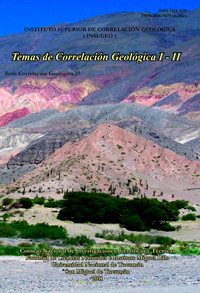Serie Correlación Geológica 27
Modelo geofísico de contacto entre el Orógeno Pampeano y el Cratón del Río de La Plata en las provincias de Córdoba y Santiago del Estero.
Roberto César Miró | Gustavo Alejandro Ramé
Descargar trabajo en formato PDFResumen
MODELO GEOFISICO DE CONTACTO ENTRE EL OROGENO PAMPEANO Y EL CRATON DEL RIO DE LA PLATA EN LAS PROVINCIAS DE CORDOBA Y SANTIAGO DEL ESTERO.- Con el objeto de ampliar el modelo del contacto entre el cratón del Río de la Plata (CRP) y el Orógeno Pampeano (OP) se confeccionaron tres perfiles gravimétricos en el sentido este-oeste, a los 29º20’ S, 32º30´ S y 33°20’S, correspondientes a la latitud de las localidades de Sumampa (Santiago del Estero), Sierra de las Peñas y extremo sur de la sierra de Comechingones de Córdoba. Los resultados obtenidos indicarían que las nuevas secciones transversales poseen una marcada correlación con la sección de los 31°S (Perfil Jesús María) realizada anteriormente. De esta manera se estableció un modelo geofísico del contacto entre el CRP y el OP para un sector al este de las sierras de Córdoba y Santiago del Estero, entre los 29°S y los 33°20’S y los 62º y 65º O, en el que se reconocieron las siguientes unidades geotectónicas; el CRP, formado por rocas con una densidad media de 2.83 g/cm3; el OP conformado por, un arco magmático cámbrico (AMC) al este que incluye una asociación monzogranito-granodiorita de tipo I, y unidades metamórficas que forman el prisma de acreción al oeste del arco (PAc), que contienen una asociación de granitos peraluminosos. Finalmente, en los tres nuevos perfiles se alcanzó el sector al oeste de Córdoba, en la provincia de San Luis, que contiene complejos metamórficos ordovícicos (CMO). Los perfiles geofísicos poseen una base de conocimiento geológico en el sector en que atraviesan al OP contenida en diversos trabajos de detalle. Como resultado del estudio se puede afirmar que el contacto entre el CRP y el OP a la latitud de las Sierras Pampeanas de Córdoba tendría una forma elíptica ubicada aproximadamente a los 63º30´O, por debajo de la llanura chacopampeana. El contacto entre ambas unidades sería a través de una lámina tectónica con disposición subvertical que involucraría todo el espesor de la corteza y tendría un ancho estimado de 20 km. Evidencias estructurales descriptas en el ámbito de las sierras Norte, Ojo de Agua y Sumampa habrían definido importantes cizallas dentro de granitos cámbricos (525 Ma) que podrían vincularse al momento del acople entre el CRP y AMC. La impronta gravimétrica actual del cratón del Río de la Plata en el sector inmediatamente al este de las Sierras Pampeanas de Córdoba y Santiago del Estero evidencia el desmembramiento que sufriera a partir de la tectónica neopaleozoica y el rifting cretácico, reactivada posteriormente durante el ciclo terciario Ándico, en coincidencia con estudios sísmicos que muestran que bajo la llanura de Córdoba, entre los 64º O y el río Paraná, a los 60º O, la superficie del cratón presenta fuertes desniveles con bloques de orientación norte-sur, siguiendo el estilo tectónico de las Sierras Pampeanas aflorantes hacia el oeste.
Abstract
GEOPHYSICAL MODEL OF CONTACT BETWEEN THE PAMPEAN OROGEN AND THE RIO DE LA PLATA CRATON IN PROVINCES OF CORDOBA AND SANTIAGO DEL ESTERO.- In order to better understand the model of contact between Rio de la Plata craton (CRP) and the Pampean Orogen (OP) three gravity profiles, east-west oriented, were performed at 29º 20'S, 32º 30'S and 33° 20'S, corresponding to the latitude of the localities of Sumampa (Santiago del Estero province), Sierra de las Peñas and southern end of the Sierra de Comechingones, Cordoba province. The obtained results point to a strong correlation between the new sections and the one at 31°S (profile Jesús María) made earlier. On that base a new geophysical model of contact was established between the CRP and the OP for a sector east of the Sierras de Cordoba and Santiago del Estero province, from 29° S to 33° 20'S and 62º to 65 º W, in which the following geotectonic units were recognized: the CRP, as a massive block with an average density of 2.83 g/cm3; the OP, formed by a Cambrian magmatic arc (AMC) to the east, that includes a monzogranite-granodiorite association of type I and metamorphic units that form the accretionary prism (PAC) to the west of the arc, containing an association of peraluminous granites. In addition to geophysical profiles the OP have a base of exhaustive geological knowledge in the study area, contained in detailed surveys. The new profiles reached the western sector of Cordoba, in the province of San Luis, containing Ordovician metamorphic complexes (CMF). As a result it can be said that the contact between the CRP and the OP to the latitude of the Sierras Pampeanas de Córdoba have an elliptical shape located approximately 63º 30'W, under the Chaco-Pampean plain. The contact between the two units would be shaped as a tectonic sliver with subvertical arrangement along the entire thickness of the crust and have a width estimate of 20 km. Structural evidence described in the area of Sierra Norte and Sierra de Sumampa have defined important shears zones within Cambrian granites (525 Ma) that could be linked at the time of the coupling between the CRP and the OP. The current gravimetric surface pattern of the Río de la Plata craton, in the area immediately to the east of the Sierras Pampeanas of Cordoba and Santiago del Estero province, is an evidence of the dismemberment that occurred since the Upper Paleozoic tectonics and Cretaceous rifting, subsequently reactivated during the Andico tertiary compressional cycle. Seismic studies show that under the plain of Cordoba province, between 64° W and the Paraná River at 60º W, the surface of the craton has steep slopes, with blocks of north-south orientation, in similarity with the tectonic style of the Sierras Pampeanas outcropping to the west.






